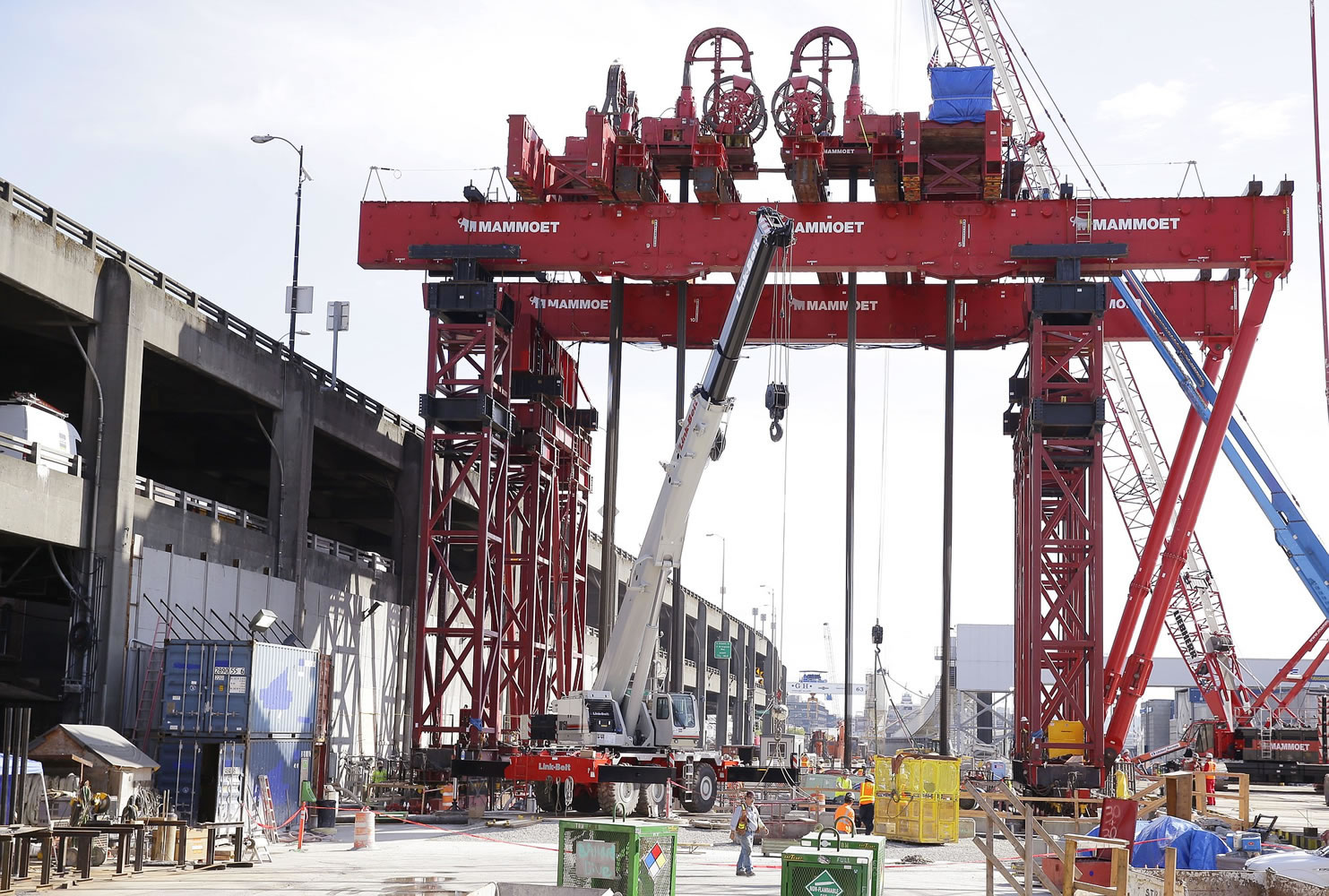On Monday, that red tower along the Seattle waterfront began to lift a 4-million-pound piece of the tunnel machine Bertha and lay it on the surface, cutter face down.
Dutch firm Mammoet started to hoist the front end of Bertha, according to a state news advisory just before 1 p.m.
The operation is expected to take up to 16 hours, state tunnel administrators say.
Safety is paramount. A major failure of cables or the tower beams could damage the deep access vault around Bertha or jeopardize the Alaskan Way Viaduct, roughly 50 feet away.
Earlier Monday, the lifting crews conducted incremental tests — pulling with less force than what’s needed to raise Bertha’s 4-million pound drive unit into the air — to confirm that the motors and cables are up to the task, according to Laura Newborn, spokeswoman for the Washington State Department of Transportation.
After several hours, the parts will be slowly laid onto a stand 17 feet south of the repair vault, for dissassembly.
The five-story tower was custom-engineered to perform a few critical lifts to deliver the tunnel machine’s megaparts to a repair area. A unique system of 48 hydraulic cylinders is designed to maintain balance, by counteracting any slight shifts in the suspended load.
Mammoet is performing the hoist for Hitachi-Zosen, which built the $80 million tunnel-boring machine, the world’s largest.
Bertha overheated and stopped drilling Dec. 6, 2013, when grit penetrated the rubber seals that protect the bearing. The bearing will be replaced, stronger seals installed and the cutting disc altered to have wider openings for dirt to pass through.
This month, a tall crawler crane successfully picked three pieces of the machine’s outer shell from a deep access vault Seattle Tunnel Partners dug around the front of the machine. Chris Dixon, STP project manager, hopes to resume mining under the viaduct and toward South Lake Union by August.
The Washington State Department of Transportation has decided to keep the viaduct open to traffic during the delicate operation.
Matt Preedy, deputy Highway 99 tunnel administrator for WSDOT, has said if the lift runs into problems, or the viaduct begins to look unsafe, the state can quickly divert traffic. The WSDOT could lower the gates it installed on highway entrances in 2011 for the purpose of halting cars during an earthquake.
Over the years, portions of the viaduct have settled because of the 2001 Nisqually earthquake, from long-term ground stresses a decade later, and from recent groundwater pumping STP employed to dig the repair vault. But this sinkage is broadly distributed, which averts a threat of sudden cracking, state bridge engineers say.
Bertha’s cutter drive is so dense that Hitachi designed a steel cradle to distribute the 4 million pounds – so the cluster won’t make a divot in the dirt. The piece will be laid 16 1/2 feet south of the repair vault, where Alaskan Way meets South Main Street.
Days later, the lift tower will pull out the bearing assembly, and set that an additional 17 feet south.
People can follow the mission through the WSDOT pit-cam, at www.wsdot.wa.gov/projects/viaduct/Traffic/ConstructionCam.
Mammoet has accomplished bigger lifts, including of the sunken Russian submarine Kursk.
This year, its engineers are planning to roll and lower a giant cap over the contaminated Chernobyl nuclear plant, site of a catastrophic accident in 1986.
The Chernobyl cap, which resembles the roof of Safeco Field, will be 15 times as heavy as Bertha’s front end.



